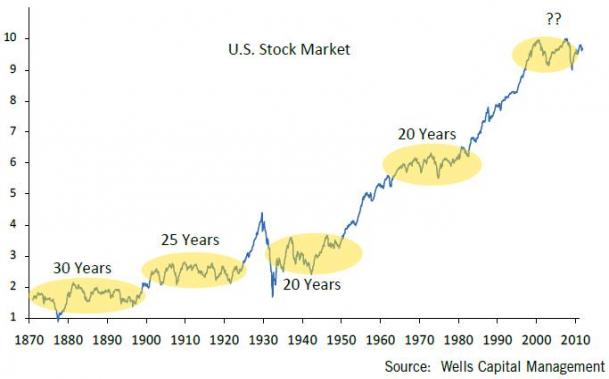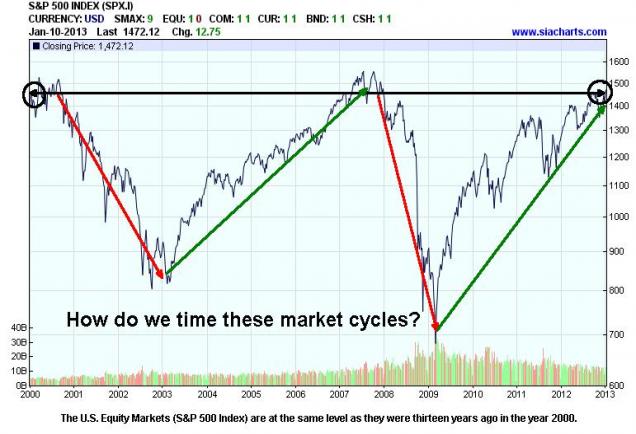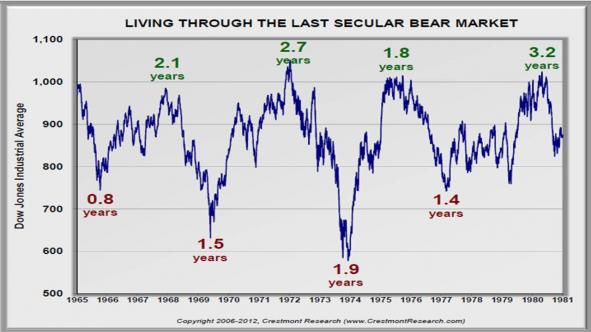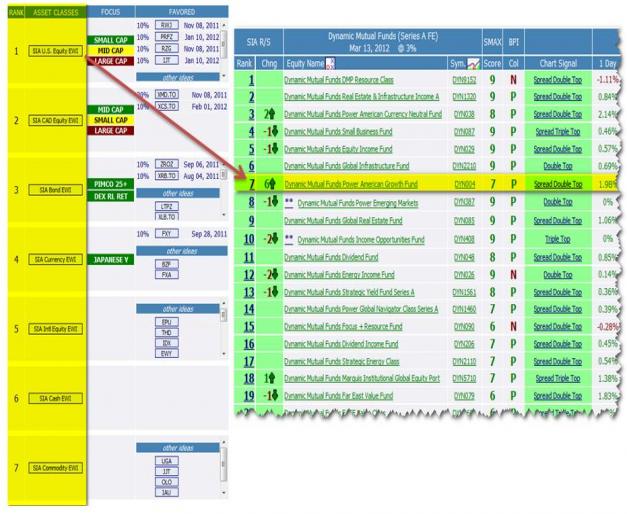Relative Strength Solution
 Problem: Buy and Hold Strategy doesn’t work in Sideways Markets
Problem: Buy and Hold Strategy doesn’t work in Sideways Markets
Thirteen years of sideways markets have proven that modern portfolio theory and the buy and hold strategy does not work. Let me explain. What many investors don’t realize is that long-term sideways markets are actually the norm and not the exception. Not all decades are going to be like the 1950’s or 1990’s and in fact the markets were range-bound approximately 75% of the time or 106 out of the past 142 years. As you can see below, these range-bound periods often last between 20-30 years as well.

The U.S. markets have been flat over the past thirteen years (see chart S&P 500 chart in Figure 2). So, if we can agree that we are currently in another range-bound trading period like history shows above, simply buying and holding the S&P 500 during this sideways market is a losing strategy and one that too many investors have found themselves in lately. If an investor had put $10,000 into an S&P 500 tracking index on January 3, 2000 and took it out on January 3, 2013, they would have lost money if you take inflation, fees, taxes, etc. into account.

Taking a closer look at the past thirteen years for the S&P 500 Index, we can see that there have been four key periods within this time frame of bearish and bullish market cycles. You can break it down even further. Looking at the previous sideways market period from 1965-1981 in Figure 3, this market saw five bearish corrections with four bullish rallies averaging 2.5 years on the bullish rallies and 1.5 years on the bearish corrections.

So how do we invest during these volatile time periods? Well, the key is asset class timing, which is the rotation of asset allocation between asset classes such as U.S. equities, Canadian equities, International equities, commodities, currencies, bonds, and cash. You obviously want to be in more defensive asset classes when the market starts a correction and well invested in more aggressive asset classes when a rally starts. But it is impossible to consistently make these judgment calls with so many media sources giving differing opinions, emotional attachment to certain holdings, biased fundamental research, and overwhelming investment choices. You need a rules-based unbiased system that has proven it can help you adjust your asset allocation and protect you from these market pull-backs within the sideways markets. By eliminating your exposure to equities during these bearish down-turns, this will not only protect your assets and minimize your risk, but also help you see consistent outperformance of benchmarks.
Solution: SIA Relative Strength Solution
What is relative strength? Relative strength is a technique that compares the performance of an asset class or holding against other asset classes or holding(s). Relative Strength calculates which investments are the strongest relative performers by comparing each asset class or holding against the other available choices. Relative strength between asset classes gives us insight into money flow on a large scale. By understanding where money flows are moving, we can assess Risk vs. Reward for any asset class, sector, or group of investments. SIA’s database includes over 60,000 stocks, ETFs, Canadian and U.S. mutual funds, commodities, currencies, etc. which are analyzed daily to help understand these money flows.

Above in Figure 4, we see the SIA Equity Action Call © which has been the answer to the asset class timing problem we addressed earlier to know when these bearish corrections or bullish rallies are happening. This Equity Action Call successfully helped keep investment advisors out of the equity markets in 2008 and rotated them into Cash, Bonds, or Commodities saving their clients countless dollars and grief. So instead of just having a buy and hope strategy, we can improve our alpha and lower our beta by having an asset rotation strategy and rotating to the strongest asset classes utilizing this relative strength technology.
Real World Example:
Since October of 2011 until now, the U.S. Equity markets have been outperforming the Canadian Equity markets by about double and continue to do so. Why are Canadian Advisors still overweighting the Canadian stock universe when the outperformance is coming elsewhere? Many investment advisors may not have a technical investment tool to help them identify when these significant macro-economic changes occur. Below, in Figure 5 is an example of how to very easily help you find which asset class you should be focusing on and then taking it a step further, quickly find the mutual fund or investment you should be selecting. These proprietary SIA Relative Strength reports help licensed investment professionals choose entry and exit points of investments and help minimize the risk for their clients.

What is the value add that your advisor provides to you? Are they using a tool to help minimize your risk and help with important asset class timing? If not, tell them to take a look at www.SIACharts.com (for investing in stocks, ETFs, Mutual Funds, Forex, Futures, etc.) or www.SIAFunds.com (just analysis on Canadian Mutual Funds) which is redefining investment management and your solution to investing in the current sideways market. Don’t let what happened in 2008 ever happen again to you!
SIACharts, based out of Calgary, is Canada’s largest and most advanced technical analysis advisory website, catering specifically to licensed investment professionals only. SIACharts does not make their services available to non-professional individuals, so tell your advisor about SIACharts or SIAFunds today to ensure they have a market timing tool to protect your assets and help find outperformance.
**SIACharts.com specifically represents that it does not give investment advice or advocate the purchase or sale of any security or investment. None of the information contained in this website or document constitutes an offer to sell or the solicitation of an offer to buy any security or other investment or an offer to provide investment services of any kind. Neither SIACharts.com (FundCharts Inc.) nor its third party content providers shall be liable for any errors, inaccuracies or delays in content, or for any actions taken in reliance thereon.
By Paul Kornfeld, Vice President of SIACharts
Click Here to subscribe to the Print edition of Canadian MoneySaver Magazine
for $26.95(+tx)per year.


